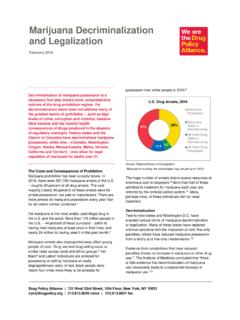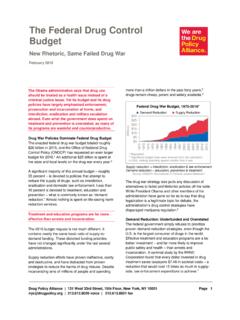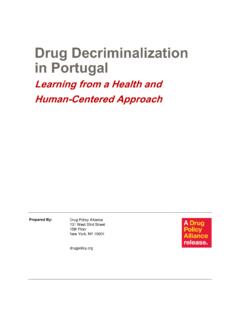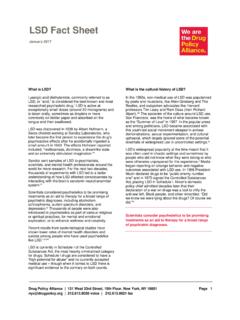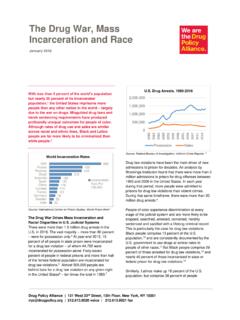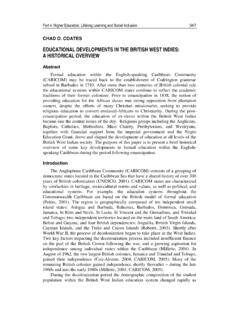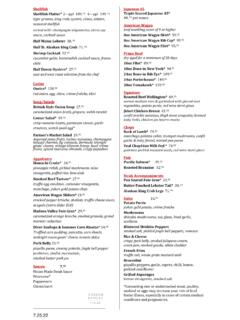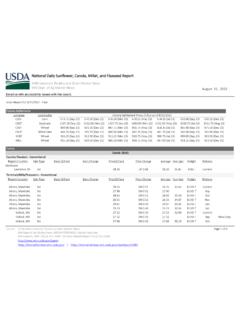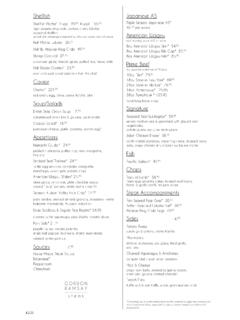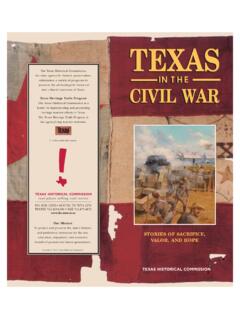Transcription of Psilocybin Mushrooms Facts Sheet Final
1 Drug Policy Alliance | 131 West 33rd Street, 15th Floor, New York, NY 10001 | voice | fax Page 1 Psilocybin Mushrooms Fact Sheet January 2017 What are Psilocybin , or magic, Mushrooms ? Psilocybin is the main ingredient found in several types of psychoactive Mushrooms , making it perhaps the best-known naturally-occurring psychedelic Although Psilocybin is considered active at doses around 3-4 mg, a common dose used in clinical research settings ranges from 14-30 ,iii,iv Its effects on the brain are attributed to its active metabolite, psilocin. Psilocybin is most commonly found in wild or homegrown Mushrooms and sold either fresh or dried. The most popular species of Psilocybin Mushrooms is Psilocybe cubensis, which is usually taken orally either by eating dried caps and stems or steeped in hot water and drunk as a tea, with a common dose around Scientists and mental health professionals consider psychedelics like Psilocybin to be promising treatments as an aid to therapy for a broad range of psychiatric diagnoses.
2 What is the history of psychoactive Mushrooms ? Psychoactive Mushrooms have been used for thousands of yearsvi and have a long history of both medicinal and ceremonial use among indigenous peoples in many parts of the world, including Europe and the ,viii,ix,x They were re-popularized in 1957, when a photo essay featuring an American banker and mushroom enthusiast R. gordon Wasson was published in LIFE Four years earlier, Wasson had stumbled across an indigenous tribe using psychoactive Mushrooms in Mexico while on vacation and brought back a sample that he then sent to the Swiss chemist known for discovering LSD, Albert Hofmann. Hofmann isolated Psilocybin and developed a synthesis for the drug in his lab at Sandoz Pharmaceuticals, which then started producing 2 mg pills to be distributed for research For the next two decades thousands of doses of Psilocybin were administered in clinical experiments.
3 Psychiatrists, scientists and mental health professionals considered psychedelics like Psilocybin to be promising treatments as an aid to therapy for a broad range of psychiatric diagnoses, including alcoholism, schizophrenia, autism spectrum disorders, obsessive-compulsive disorder, and Many more people were also introduced to Psilocybin Mushrooms and other psychedelics as part of various religious or spiritual practices, for mental and emotional exploration, or to enhance wellness and Despite this long history and ongoing research into its therapeutic and medical benefits,xv since 1970 Psilocybin and psilocin have been listed in Schedule I of the Controlled Substances Act, the most heavily criminalized category for drugs considered to have a high potential for abuse and no currently accepted medical use though when it comes to Psilocybin there is significant evidence to the contrary on both counts.
4 What are the short term effects of Psilocybin Mushrooms ? The effects of psychedelic drugs like Psilocybin Mushrooms vary tremendously, and are difficult to categorize they affect different people, at different places, and at different times, with incredible ,xvii However, Psilocybin and other psychedelics are known for their profound changes in consciousness and perception. Psilocybin s effects last around 4-6 hours, with peak effects occurring 2-3 hours after ingestion. These effects include sensory enhancement, sense of time changing (minutes can feel like hours), real or imagined objects appear to be moving (flowing patterns and shapes) both with eyes open or closed, 2 Drug Policy Alliance | 131 West 33rd Street, 15th Floor, New York, NY 10001 | voice | fax Page unusual thoughts and speech, personal insight and reflection, and excited Individual reactions to these perceptual changes are very much based on set and Set (or mindset ) refers to the psychological state and the beliefs of the person taking the drug.
5 Setting is the external circumstances they re in the people around them and their environmental surroundings. Because set and setting vary so widely from person to person, and even from experience to experience, each Psilocybin experience can produce vastly different outcomes from frightening to deeply meaningful and positive, life-changing experiences (though some parts may still be overwhelming or psychologically jarring). Can Psilocybin Mushrooms be used as medicine or therapy? Strong evidence suggests yes. Fully legal, well-funded research programs in the mid-20th century found that carefully monitored and controlled use of Psilocybin may be beneficial for many psychiatric disorders, personal and spiritual development, and creative However, after Psilocybin was banned in 1970, clinical research to evaluate its medical safety and efficacy of psychedelics was effectively halted until the late 90s and early Today, there are dozens of studies taking place to evaluate the medical safety and efficacy of psychedelics, including Psilocybin .
6 Much of the early research did not stand up to today s standards, as they often lacked a placebo control group or double-blinding procedures (in which neither the subject of the research nor the investigators knew whether the subject received Psilocybin or placebo). Nevertheless, their promising findings have been revisited and spurred a resurgence of new, more rigorous research on the potential benefits of psychedelics as a treatment for cluster headache,xxi anxiety,ii,iii,iv addiction to alcohol and other drugs,xxii depression,xxiii obsessive-compulsive disorder,xxiv as well as neuroimaging experiments furthering the understanding of its effects on the Because of the expensive and labyrinthian approval process for research with Schedule I drugs, as well as the political influence of the war on drugs, research evaluating Psilocybin s beneficial uses does not receive funding from academic or government institutions, and instead relies on nonprofit organizations like the Multidisciplinary Association for Psychedelic Studies, the Beckley Foundation.
7 And the Heffter Research How many people use Psilocybin Mushrooms ? Psilocybin Mushrooms are considered one of the most well-known psychedelics, but according to the Substance Abuse and Mental Health Services Administration (SAMHSA), which conducts the largest annual national survey on drug use, their use is not at all common. Psychedelic use is so low that several drugs are grouped under the category of hallucinogens, which includes LSD, peyote, mescaline, Psilocybin Mushrooms , and Ecstasy or Molly (MDMA).xxvi In each year between 2002 and 2014, an annual average of of people across all ages were considered to be current psychedelic users (meaning they reported use within 30 days of completing the survey). In 2014, of the 16,875 adolescent respondents (12 to 17 year-olds) in the US were considered to be current users of psychedelics, of the 11,643 young adult respondents (18 to 25), and of 33,750 adult respondents aged 26 or However, from 2004 2005 (the last year data for this specific question were available), around half of the people who reported trying a psychedelic for the first time used Psilocybin Mushrooms (out of approximately 67,000 respondents).
8 Xxviii Data from people reporting lifetime use of psychedelics shows similar rates across most age ranges, meaning just as many young adults in the 21st century have used psychedelics as older adults who lived through the 1960s and What are the long term health impacts of Psilocybin Mushrooms ? The risks associated with psychedelic drugs are mostly psychological, not physical. Physically, Psilocybin Mushrooms are considered to be one of the least toxic drugs Although lethal doses have been determined from experiments in several animal models,xxx recorded cases of death exclusively attributed to usual doses of Psilocybin Mushrooms in humans are extremely Physical effects are minor but varied and can be unique from person to person. The most consistent reactions, such as dilated pupils, elevated blood pressure, and increased heart rate, are usually mild, and considered side effects of emotional intensification.
9 However, these along with other reported symptoms like nausea, increased perspiration, numbing and tremors, can sometimes make psychological symptoms like anxiety, panic 3 Drug Policy Alliance | 131 West 33rd Street, 15th Floor, New York, NY 10001 | voice | fax Page attacks, paranoia, and mood swings seem Long-term physical effects directly attributed to the pharmacology of Psilocybin are rare, and research suggests they may also be due to latent psychological disorders. Comprehensive reviews of the thousands of sessions using Psilocybin and other psychedelics in legal clinical research settings during the 1950s and 60s have consistently found extremely low incidences of acute and chronic problems among individuals lacking pre-existing severe Recent reviews of the clinical literature also suggest that chronic problematic effects, when they do occur, are most often linked to psychological instability present prior to Hallucinogen Persisting Perception Disorder (HPPD), sometimes mistakenly referred to as flashbacks, is a condition unique to psychedelics, involving perceptual changes lasting weeks or months following the use of a drug like Psilocybin .
10 Though exact prevalence is unknown, HPPD is considered relatively rare, with no physical changes or neurological damage associated as the How risky are Psilocybin Mushrooms compared to other drugs? Psilocybin is considered to have extremely low toxicity, and cases of death have been extremely But beginning in the 1960s and continuing today, sensationalized media coverage of psychedelic-related deaths misattributed the role of psychedelics like Psilocybin in causing suicide or accidental death. Recent results from epidemiological studies have actually shown lower rates of mental health disorders and suicide among people who have used psychedelics like ,xxxvi,xxxvii The risks from Psilocybin are dependent on set and setting and differ from other types of drugs, including alcohol, benzodiazepines, and opiates, which produce relatively predictable physical and psychological The consequences of negative or challenging experiences can be minimized by education and awareness of Psilocybin s effects, with particular attention paid to issues around set and setting prior to the experience.
